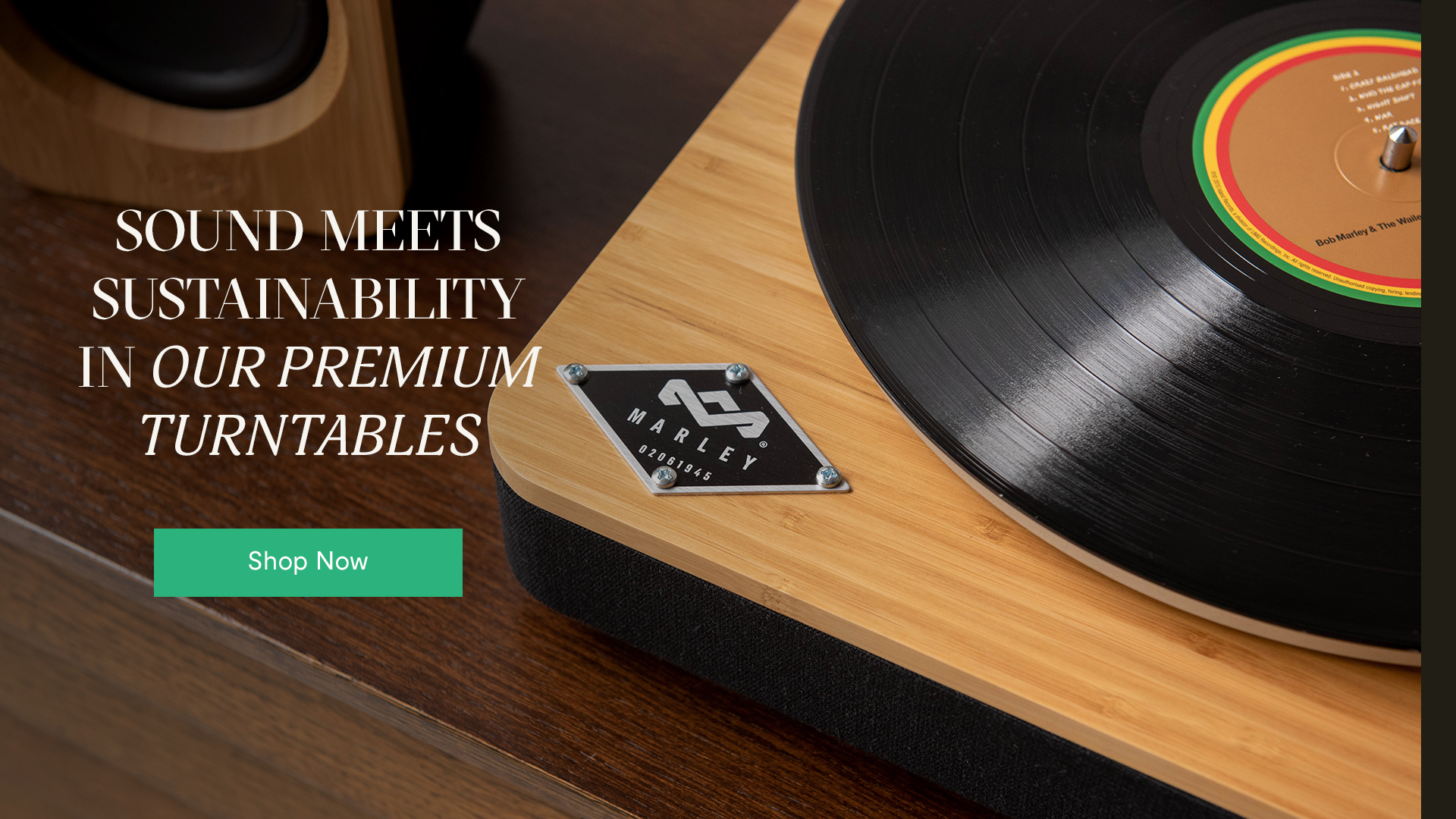How to Fix Scratches on Vinyl Records: 2 Methods
Posted by House of Marley on Sep 12th 2023
Even after decades of use and the evolution of platforms to cassette tapes, CDs, digital files, and now streaming services, there remains a classic charm with vinyl records. Those nostalgic discs transport us back in time with their unique (and purists argue, better) sound.
But, oh boy, isn't it a heartbreaker when you find a scratch on your favorite LP? If you've ever wondered how to fix scratches on vinyl records, you're in the right place. Let's dive into the nitty-gritty of scratched records and how to bring them back to life.
What Causes a Scratched Vinyl Record?
Before we jump into the deep end, let's understand the culprits behind those pesky scratches.
- Environmental factors: Dust and debris are like kryptonite for vinyl records. Over time, these tiny particles can cause surface scratches. Even if you're super careful, environmental factors like a sudden gust of wind or a mischievous pet can wreak havoc on your precious collection. Moreover, prolonged exposure to direct sunlight can warp the record, making it more susceptible to scratches. Humidity can also play a role, as it can cause the vinyl to become softer and more prone to damage.
- Improper handling: Ever seen someone grab a record by its surface? Yikes! That's a scratched record waiting to happen. Handling your vinyl records without the proper care is like dancing on thin ice; you're bound to slip up at some point. Using a record player with a damaged needle or not placing the needle gently can also lead to scratches. Learn more about what a damaged stylus sounds like to diagnose if you’re having this issue. Additionally, stacking records on top of each other without protective sleeves can cause unnecessary friction and subsequent damage.
- Manufacturing defects: Sometimes, it's not you; it's them. Occasionally, records come with minor imperfections straight from the factory. It's a bummer, but hey, nobody's perfect! These defects might be due to issues in the pressing process or even the quality of the vinyl used. Sometimes, even the best quality control measures can miss a slight imperfection, leading to a less-than-perfect playback experience.

Is a Scratched Vinyl Ruined?
It's a bit of a mixed bag if a scratched vinyl is truly ruined, as the depth of scratches plays a huge role in their impact on sound quality.
The Depth of Scratches and Their Impact on Sound Quality
Minor scratches might cause a slight pop or crackle, but deep scratches can cause a skipping record. And that's a real party pooper! It's like having a hiccup in the middle of a heartfelt ballad. However, not all scratches will necessarily distort the sound. Sometimes, a scratch might be superficial, only affecting the record's aesthetics and not its playability. But when a scratch is deep enough to disrupt the groove, that's when the real trouble starts, leading to skips or repeated sections.
When Is a Vinyl Record Beyond Repair?
If you can feel the scratch with your fingernail, it might be time to bid adieu. But don't lose hope just yet; some old records can still be salvaged. It's all about knowing when to hold 'em and when to fold 'em. There are various methods and tools available that can help in reducing the visibility and audibility of scratches. However, it's essential to approach the repair process with caution, as an incorrect method can further damage the record. Sometimes, it might be worth consulting with a professional or a seasoned record collector for advice.
Step-by-Step Guide to Fixing Scratched Records
Alright, folks, roll up your sleeves. It's repair time! These are some methods that can help get your LPs back into tip-top condition.
Preparing Your Workspace
- Cleaning the record: First things first, give that vinyl a good clean. Use a carbon fiber brush or a record-cleaning solution to get rid of any dust or debris. Remember, a clean record is a happy record! It's like giving your vinyl a spa day. Cleaning not only prepares the record for repair but also ensures that you don't introduce new contaminants during the process. Moreover, a pristine surface allows for a smoother and more efficient repair, minimizing the risk of further damage.
- Identifying the scratch: Use a soft light to spot the scratched area. This will help you focus your repair efforts. Think of it as playing detective but for records. Positioning the record at different angles under the light can make the scratches more visible. It's crucial to pinpoint the exact location and extent of the damage, as this will determine the best method for repair. A magnifying glass can also come in handy, especially for those tiny, hairline scratches that are hard to spot with the naked eye.
Method 1: The Toothpick Method
Sounds quirky, right? But trust me, it works wonders for minor scratches.
How it works: The toothpick method works by gently realigning the raised edges of the record groove caused by the scratch. This can help to reduce the amount of noise produced when the stylus passes over the scratch.
Step-by-step guide:
- Hold the record by its outer edge. Avoid touching the playing surface of the record with your fingers, as this can cause fingerprints and other smudges.
- Place the toothpick on the scratch and apply gentle pressure. Be careful not to press too hard, as this could damage the record further.
- Move the toothpick along the scratch, following the groove. Use a gentle back-and-forth motion, and be careful not to go too far beyond the scratch.
- Once you have covered the entire scratch, test the record on your record player. If the skip or pop is gone, you're good to go! If not, you can try repeating steps 2 and 3.
Additional tips:
- For best results, use a sharp toothpick.
- If the scratch is deep, you may need to apply more pressure. However, be careful not to overdo it.
- If you are unsure whether or not you are applying too much pressure, it is better to err on the side of caution and apply less pressure.
- If the scratch is very long, you may want to break it up into smaller sections and work on each section individually.
- If you are having trouble seeing the scratch, you can use a magnifying glass to help you.
Be careful not to damage the record further!
If you are not comfortable using the toothpick method, or if the scratch is too deep, you may want to consider taking the record to a professional for repair.
Method 2: The Epoxy and Wood Glue Method
This one's for those deep scratches that need some extra TLC.
How it works: The epoxy or wood glue fills in the scratch, creating a smooth surface for the stylus to glide over. When the glue is peeled off, it takes the raised edges of the scratch with it, leaving the record groove smooth and playable.
Step-by-step guide:
- Clean the record thoroughly. Use a record-cleaning brush and a mild cleaning solution to remove any dust, dirt, or fingerprints from the record surface. Be sure to dry the record completely before proceeding to the next step.
- Apply a thin layer of wood glue over the record surface. You can use a toothpick or a small brush to apply the glue. Be careful not to apply too much glue, as this can make it difficult to remove the glue later.
- Let the glue dry completely. This may take several hours, depending on the type of glue you are using.
- Gently peel off the glue. Start at the outer edge of the record and work your way towards the center. Peel slowly and carefully to avoid damaging the record.
Additional tips:
- If the scratch is deep, you may need to apply multiple layers of glue.
- If you are using epoxy, be sure to mix the two parts according to the manufacturer's instructions.
- If you are having trouble peeling off the glue, you can try using a damp paper towel to help soften it.
- Be careful not to touch the playing surface of the record with your fingers while the glue is drying.
Once the glue has been removed, your record should be ready to play!
If you are not comfortable using the epoxy and wood glue method, or if the scratch is too deep, you may want to consider taking the record to a professional for repair.
Preventive Measures for Protecting Your Vinyl Records
An ounce of prevention is worth a pound of cure, right? Practice the following tips and you can bet that your vinyl collection can last you a lifetime.
How to Hold a Vinyl Record
Always hold a vinyl record by the outer edge or the labeled part. Avoid touching the grooves. It's like holding a baby; you've got to be gentle and careful. The oils and dirt from your fingers can degrade the record's quality over time. Proper handling ensures that you don't accidentally introduce any new scratches or contaminants to the vinyl.
Cleaning and Maintenance
Regular cleaning with a record brush or cleaning solution will keep those records spinning smoothly. It's like giving your records a regular check-up. But don't forget about the needle! Understanding how to clean a record player needle is just as crucial, as it ensures the best sound quality and longevity of your player. Cleaning not only removes dust but also helps in maintaining the record's luster and shine. When it comes to how to clean vinyl records, using anti-static brushes or solutions can help reduce static build-up, which can attract more dust to the record's surface.
Storage Solutions
The Role of Inner and Outer Sleeves
Protective sleeves are like armor for your records. They shield them from dust, dirt, and damage. It's like tucking your records into bed every night. These sleeves also prevent any accidental scuffs or surface scratches when taking the record out or putting it back. Investing in high-quality, anti-static sleeves can further ensure that your records remain dust-free and in top-notch condition.
Choosing the Right Storage Space
When it comes to how to store records, store your vinyl collection vertically and away from direct sunlight. And for the love of music, avoid stacking them! It's like finding the perfect home for your beloved collection. Stacking can exert pressure on the records at the bottom, leading to potential warping. Additionally, ensure the storage space is cool and dry, as humidity can cause the records to become soft and more susceptible to damage. Learn more about how to fix a warped record if you find yourself in this situation.

Reviving the Vinyl Experience with House of Marley
Now, what's the point of having pristine records if you don't have a top-notch turntable? Enter House of Marley. Our turntables, like the Stir It Up and the Stir It Up Wireless, are a treat for any record collector. And if you're looking to really elevate your audio experience, the Stir It Up Lux Wireless Turntable and various turntable bundles are the cherry on top.
In a nutshell, while scratches on vinyl records can be a bummer, they're not the end of the world. With a bit of care, some DIY magic, and a killer turntable from House of Marley, you'll be grooving in no time. So, keep the records spinning and let the music play on!













